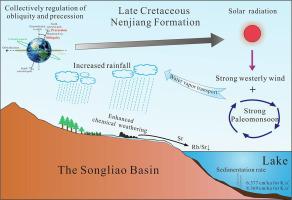当前位置:
X-MOL 学术
›
J. Asian Earth Sci.
›
论文详情
Our official English website, www.x-mol.net, welcomes your feedback! (Note: you will need to create a separate account there.)
Recognition of Milankovitch cycles in XRF core-scanning records of the Late Cretaceous Nenjiang Formation from the Songliao Basin (northeastern China) and their paleoclimate implications
Journal of Asian Earth Sciences ( IF 3 ) Pub Date : 2020-06-01 , DOI: 10.1016/j.jseaes.2019.104183 Hanfei Yang , Yongjian Huang , Chao Ma , Zhifeng Zhang , Chengshan Wang
Journal of Asian Earth Sciences ( IF 3 ) Pub Date : 2020-06-01 , DOI: 10.1016/j.jseaes.2019.104183 Hanfei Yang , Yongjian Huang , Chao Ma , Zhifeng Zhang , Chengshan Wang

|
Abstract Cretaceous terrestrial sedimentary records are crucial for our understanding of geological systems’ responses to past climate change under greenhouse condition. Numerous publications have documented that Milankovitch cycles were a dominant climate driver over multi-millennial timescales. However, most of these orbital signals were derived from marine records obtained during the Cenozoic geological period, whereas knowledge of Milankovitch cycles preserved in lacustrine sediments prior to the Cenozoic is limited due to the lack of a precise chronological framework, poor preservation rate of terrestrial sediments, limited records, and fewer experts in this research area. This paper reports high-resolution X-ray fluorescence (XRF) elemental records of K, Ti, Rb, Sr, Zr, Zr/Rb, Rb/Sr, and K/Ti from Member 1 (k2n1) and Member 2 (k2n2) of the Nenjiang Formation, which were obtained from a near-continuous SK-2 East (SK-2e) borehole drilled in the Songliao Basin (SB) of northeastern (NE) China. Variations of the elemental records reveal a humid-arid-humid-semiarid climatic evolution throughout the deposition of k2n1 and a humid-arid-humid-arid climatic variation throughout the deposition of k2n2. In this context, K2n1 experienced a relatively longer humid period and more pronounced climatic fluctuation than K2n2. A method of average spectral misfit (ASM) was adopted to successfully identify two optimal sedimentation rates of 6.577 and 8.369 cm/ka for K2n1 and K2n2, respectively. Based on these two sedimentation rates, nearly all significant Milankovitch cycles preserved in the Rb/Sr record were recognized. It is suggested that westerly wind was the main climatic driving factor of climate evolution in the SB under the forcing of Milankovitch cycles. The collectively regulation of obliquity and precession increased the seasonal contrasts during humid periods in the Nenjiang Formation and thereby amplified the paleomonsoon effect, thus bringing more moisture towards the SB and lead to enhanced rainfall.
更新日期:2020-06-01



























 京公网安备 11010802027423号
京公网安备 11010802027423号